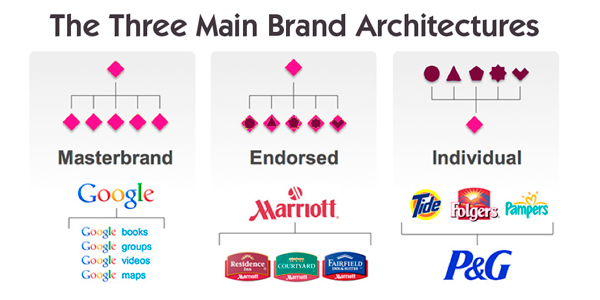Brand Hierarchy Fundamentals for Multiple Brands To Avoid Confused Customers or Stagnant Sales
Brand hierarchy, also known as brand architecture, isn’t always easy or an obvious strategic factor within an organisation for a lot of business owners, senior managers and entrepreneurs. Most business owners don’t start thinking about organizing their product and service portfolio until they have several product lines and the relationship between the products is often extremely vague. It is then that the panic frequently kicks in and you realize that the customer is confused and unable to choose, which in turn affects your bottom line.
Fortunately, establishing a strong product structure isn’t as hard as you may think and can be done at almost any stage of business development. Having said that though it is far more cost effective to get your product structures and strategic planning in place early rather than trying to fix costly problems later which may require a rebrand. The structure of your products and services doesn’t have to be highly complex either because it’s absolutely doable to create a beautifully simple structure that will result in reinforced customer love and brand loyalty.
Brand Hierarchy: Your Guide to Managing Multiple Product, Services and Subproduct Brands Using The Right Brand Architecture to Grow Sales
Check out this video where Sasha Strauss explains the key benefits of brand hierarchy, also known as brand architecture, in simple terms:
Not all businesses need very detailed product or service structures, however, if you have multiple products or services in your portfolio, the sooner you start organizing them the better because you don’t want to lose clients or profits. Just look at Sony and how many problems the brand[1] is facing now because it uses the same master brand for all its products and services.
The best way to get back on track with your brand and product offering is to conduct a brand audit. A brand audit is effectively a health check of your brand to identify and address problems areas with a net result of helping you turn things around and grow your bottom line.
Just like a brand audit, our Auditing Analysis Accelerator™ Programme enables you to audit your brand yourself so you can identify areas of weakness and pinpoint new opportunities for innovation and growth to increase your profits.
4 Key Reasons Why You Need to Organize Your Product and Service Brand Hierarchy
1. Customers Confusion
Start with the most important part of your business. If your customers are confused and don’t understand your offering they will default to price based decisions or may not buy at all so it may be time to build your product or service structure — known as brand architecture or brand hierarchy.
How do you determine how customers feel about your products? You can look at website analytics, in particular, the behaviour maps, that show how customers behave on your website and which buttons and images they pay most attention to. If your customers spend too much time on your website, jumping between similar products and brands and then leave without making a purchase they are most likely confused. You can also use customer phone surveys and social media polls to get more in-depth data.
Customers in the 21st century dictate how brands are built. In this next video, Jeffrey Rayport explains the relationship between brands and customers.
Customers lead the conversation. In the highly competitive environment of today, if customers don’t understand your offering and your brand purpose, they will leave or turn to your competitor.
Related: Purposeful Brands: Why Customers Are Prepared to Pay More
2. No Solid Rationale Behind New Brands
New products are often created without enough substantive strategic thinking following customer feedback, and new brands are created automatically as soon as the product or service idea is brought to fruition. But rarely do people make the time to think through the brand strategy for the new product or service.
When you can’t articulate clearly as to why you launched the product or what the product/service brand stands for it’s time to reevaluate your portfolio. You need to decide the right structure for your products or services and how they relate to each other, your customer journey, your sales funnels, upsells and cross-sells so you can maximise growth, profits and customer longevity.
3. Primary Brand is Being Overshadowed by Sub Brands
Often times, sub products achieve such enhanced popularity within a customer base resulting in the primary brand losing its initial appeal. This can negatively affect business results especially if the primary brand represents a product that is still sold and advertised.
In this case, having a strong primary brand positioning will solidify the primary brand within its hierarchy portfolio because if you couple it with the right brand architecture it will prevent both primary brand and sub-brands from competing with, or undermining each other.
Related: How to Use Brand Positioning to Build Brand Impact in an Overcrowded Market
4. Disorganised Brands Undermine Future Business Planning
Success in business depends on many factors, but the careful planning of marketing strategy is one of the most important elements. If you don’t have a proper structure in place, it’s going to be hard to allocate resources and budgets and determine priorities. In business, every minute counts, so if you spend weeks trying to prioritize products and brands, this might be the time to reassess your brand structure.
Each new brand can require its own range of brand collateral and sometimes a brand style guide. When you have a proper structure in place, you know exactly what marketing materials each brand needs so can avoid unnecessary expenses.
In order to fix the negative implications of incorrect brand structures, professional help may be needed. With the Auditing Analysis Accelerator™ Programme you can reevaluate and establish complete clarity and focus on what your brand stands for and what makes it different so you can ensure all your brands relate to each other appropriately and are relevant to your customers, now and into the future, and you can sell them more effectively

Audit your brand now so you can reevaluate your brand architecture to avoid confusion and maximise sales.
Alternatively, you can opt for our brand audit service. A brand audit is a thorough examination of your brand’s current position in the market compared to its competitors. It identifies areas of strength, weakness, opportunities for innovation and growth together with and a review of the effectiveness of your brand architecture.
3 Benefits of Having a Product or Service Brand Hierarchy
Having a clear brand structure has a plethora of benefits and here are just some of them:
1. Clarity of Offering
When every brand is clearly defined, it simplifies the choice for the customer. People make a purchasing decision based on two factors: emotional offering and functional benefits. With a clear brand structure, you can assign certain emotional values to each product or brand and list functional benefits so you don’t need to worry about the customers getting mixed signals.
Related: Brand Profiling – How to Use Emotion to Make Your Brand More Profitable
2. Each Brand Attracts Attention Appropriately
When you separate brands by clarifying the brand strategy for each product, you prevent brands from competing with each other. Each brand has it’s own brand story to tell, it’s separate clearly defined market and ideal target customer.
Brand strategy, in general, puts a product in the certain box in people’s minds, it serves as a guiding force in all the purchasing decisions. When you organize products and services using brand architecture, you help customers choose from the multitude of available options competing for their attention.
3. Cross-Sells and Upsells are Easier

Image via Tabarnapp
Even though people love new products, and having an innovative new brand in your portfolio increases the opportunities for making a sale, sales professionals often struggle with multiple product portfolios unless they have a clear brand hierarchy.
Related: Brand Innovation – How to Identify New Growth Opportunities
Without a strong brand architecture in place, it’s harder to decide which products are complementary and are intended to supplement the main purchase. It’s also almost impossible to match customer needs and expectations – you may accidentally offer customers the product aimed at a different customer segment, and unintentional sabotage or undermine the brand image in the main purchase.
Four Different Types of Product and Service Brand Hierarchies and Case Studies
When it comes to brand architecture, marketers typically define three structures:
1. Umbrella or Branded House, also called Master Brand
In this model, the firm is the brand. In the Branded House, the Master Brand is always present and linked to all products and subproducts.
For example, FedEx has several business branches, each responsible for a certain type of service: Freight, Express, Supply Chain Service and so forth. Even though these are company departments that conduct different types of operations, they are all united under the same brand – FedEx.

Image via FedEx
The Branded House architecture is often used by small businesses due to its simplicity and the ease of management compared to other brand structures. There is only one set of branding elements and the focus is always on one brand.
Filicori Zecchini is an Italian brand that produces coffee, tea and chocolate. They also have a set of locations across the USA. Each product has a separate website section, but all products are related to the coffee shop industry.

Image via Filicori Zecchini
2. Product or House of Brands
House of Brands is the second most common type of Brand Architecture. This structure focuses on creating and building independent subproducts and their brands, while the main parent or corporate brand sits discreetly in the background.
A well-known example of a House of Brands is P&G (Proctor and Gamble). You probably know many of the company’s products such as Always, Ariel and Ambi Pur, but P&G is not the dominant brand factor.
For example, you won’t see the main brand logo prominently displayed other than on the back of the packaging. This situation is changing, however, with parent brands enhancing visible presence deliberately. It’s increasingly hard to stand out in in our highly competitive markets, so parent brands are using their power rooted in corporate responsibility and impressive brand history to support their sub-brands. You will often see the parent brand logo at the end of the advert or in the more prominent place on the packaging. This is an ‘Endorsed’ brand strategy where the House of Brands incorporates the elements of the parent or corporate brand into their strategy.

Image via Garage Project
House of Brands structure is used less frequently by smaller businesses because it needs bigger resources to develop and sustain but there are still some real live examples. Check out Garage Project – a craft beer brand. Whenever the company launches a new product, a new brand is created, whilst Garage Project[2] brand presence is almost unnoticeable. The beer brands are clearly recognized with custom fonts and illustrations for each brand, but there is no consistency due to each brand being treated as a separate individual brand.

Image via Garage Project
Another example of House of Brands is Bailey Richert’s personal brand that also includes customer service brands such as Infopreneur Institute, Virtual Summit School and Infopreneur On Air service. Even though all brands are united by the same personal brand, they are easily recognizable and have their own unique brand names. Perhaps, the budget constraints were the only thing that prevented the creation of separate websites and logos for each brand.
Related: Personal Branding: We Are All CEOs (Part 1)
3. Endorsed
These are individual brands that are connected to the parent brand, however, unlike the Branded House, the parent brand neither takes the centre stage nor does it stay in the background. The parent brand is simply present in all communication. This structure is particularly beneficial for brands that have a strong parent brand, but weaker sub-brands.
This brand structure is used by Mariott and Facebook. The presence of the parent brand is often emphasized on the logo, or, as in Facebook’s case, is explained by adding the “by Facebook” phrase to all sub brand’s communication.

Image via Facebook
4. Hybrid
Hybrid brands combine characteristics of all three brand structures. These companies mix and match until they come to the perfect unique solution. This structure is often used when a brand is acquiring new brands through merger and acquisition and the new brands don’t fit into the current brand structure.
Hybrid brand structure works best for large conglomerates because they have all the resources to manage the complex relationships between the brands.
Amazon has a hybrid brand structure. The e-commerce giant has many distinctly different sub-brands that are loosely associated with Amazon brand. At the same time, the brand developed the line of sub-products that are endorsed by Amazon brand.

Image via Labnol

Image via Deakin Business School
Another strong example is Microsoft. The company uses endorsed product brands (Office software) as well as individual brands, such as Skype and Nokia.
Your 5 Step Brand Architecture Structure Check-Up
So how do you create a product or service brand structure? Usually, building a brand structure requires 5 simple steps[3], however, all of them require substantial analytical and critical thinking work. Here is the exact step-by-step plan:
1. Identify What Confuses Customers and/or your Internal Team
Start by assessing the current situation. You might discover that you need the most simple brand structure, or that you’re already losing money because of confusion over the multitude of product/service brands in your portfolio. Either way, evaluation of your current brand structures and the creation of a new or amended structure is typically necessary because only then can you ensure that your brand, products and sub-products or services don’t compete with each other.
In your brand structure evaluation, you can draw on different resources. For businesses that have sales and marketing departments, you’ll often hear the team members’ pleas for clarification. This might be the first sign that a proper brand structure is urgently needed.
Questions from customers also indicate that something is wrong with how the brand and products are perceived. If you start getting multiple questions of the same nature on social media or through other channels, it’s time to identify what exactly confuses your customers.
2. Choose the Right Brand Architecture Model
Ask yourself the following questions:
- Is the nature of the new product so different that it can affect all other products negatively?
- Does the current brand have a lot of history and a loyal customer base?
- If you have multiple free-standing independent brands, is there a value in linking them together?
- Are new products aimed at the same audience segment and are they at risk of cannibalizing each other or core brand sales?
The answers to these questions will help point you in the right direction to select the brand architecture model that will work best for your product and service offerings so you can increase your sales.
3. Create a Mindmap of Product Brand Structures
List all your current products, services and future offerings. Describe the benefits and features[4] of each product and their target audience. Determine which benefits are functional and which are emotional. Then review each feature individually and determine its importance.
Think about what brands you can group together based on the customer segment and similarities in the emotional and functional benefits that the products deliver. Also, consider how strong the positioning of each brand is.
4. Adding a New Brand to The Portfolio
Once you commit to your brand architecture choice you need to stick to it. This means that every time you add a new product to your portfolio you need to evaluate where it fits strategically.
The best way to answer this question is to understand the value that the product brand brings. You also need to define not only the value to the customers but also the value of the overall brand portfolio.
5. Mergers and Acquisitions
Mergers and Acquisitions lead to a host of integration questions. Even before the merger occurs, you need to decide how the new brand fits into the brand structure. Here, again, the value that brand brings to your portfolio will be the major decisive factor.
There are a lot of reasons why companies merge. Sometimes, brand architecture structure is ignored in favour of future business benefit. If the current structure doesn’t work for the new brand, you might need to start from scratch and decide to develop a new structure.
Image via Finance Maps Of World
Managing The Presence of Product and Sub Product Brands
With a complex brand structure comes a complex management process. You need to make strategic decisions on how the brands are going to be resourced and managed online and offline.
Website Architecture
Brand structure determines whether you have one website or multiple websites. Some Houses of Brands opt for one corporate website and several separate product brands websites.
Bear in mind that the way you structure your website will have a large impact on search results. Here is the video that explains website silo/structure strategy and how it can help you rank higher in search. Ultimately, the more brands you have the harder it is to organize websites and ensure each one of them ranks high in search.
Social Media Architecture
It’s essential to understand how to organize social media presence for different products.
House of Brands usually choose to have separate corporate social media accounts that feature general business news and announcements, while the product brands pages are more focused on promotional messages.
This is not always the case, however, because in the House of Brands architecture the parent brand isn’t emphasized so some companies choose to skip social media altogether. For example, Alphabet, Google’s parent brand[5], doesn’t have a social media presence.
Offline Advertising and Distribution
Advertising and distribution strategies are largely dependent on the current business strategy. For example, while Hershey and Coca-Cola promote chocolate bars and BonAqua separately, they also run generalized branding campaigns where the focus is on the Master Brand.
The rationale behind Hershey’s strategy was the company’s focus on unifying all the emotional benefits into one overarching theme, defined as “happiness”.
This approach has an added benefit since running a single company campaign is usually cheaper than the creation and production of multiple campaigns.
All three aspects – website architecture, social media architecture and offline advertising and distribution, contribute to the creation of a coherent brand experience. Essentially, when you manage all these aspects you create a brand experience hierarchy, that is largely informed by your brand architecture.
Related: Top 10 Brands for Customer Experience and What You Can Learn From Them
All your current brand experiences can be evaluated and improved using a brand audit or The Auditing Analysis Accelerator™ Programme. Essentially a brand audit will reveal how the customer perceives your brand, how your brand compares to the competition, how your brand has performed and where the opportunities lie for innovation and growth. A brand audit enables you to build the right brand architecture so you can increase your visibility and your sales — without having to worry about explaining your offering again.

Audit your brand now so you can identify the right brand hierarchy to enable you to maximise your sales.
Questions to consider
- Look at your current brand portfolio. How was it formed and what shape does it have now? Can you pinpoint brand relations within the current structure?
- List emotional and functional benefits of each brand in your brand portfolio.
- Is there consistency in the current brand architecture structure or do any of the current product brands stand out?
- How many promises do you want to make to your current audience?
[1] http://www.businessinsider.com/this-is-the-biggest-problem-with-sonys-brand-2012-4
[2] http://idealog.co.nz/design/2017/02/were-more-house-brands-branded-house-garage-project-co-founder-jos-ruffell
[3] https://www.inc.com/entrepreneurs-organization/5-steps-to-structure-your-brand-for-growth.html
[4] http://www.marketingmo.com/strategic-planning/how-to-develop-your-brand-architecture/
[5] http://www.thebrandingjournal.com/2015/08/alphabet-the-new-surprising-google-brand-architecture/





Thank you very much for the Information. It was a really great help for my Branding exams, your contagiousness is pretty awesome!!!
Ankit, you’re very welcome, we’re thrilled you found this article helpful for your branding exams — I’m chuckling at your contagiousness comment 🙂